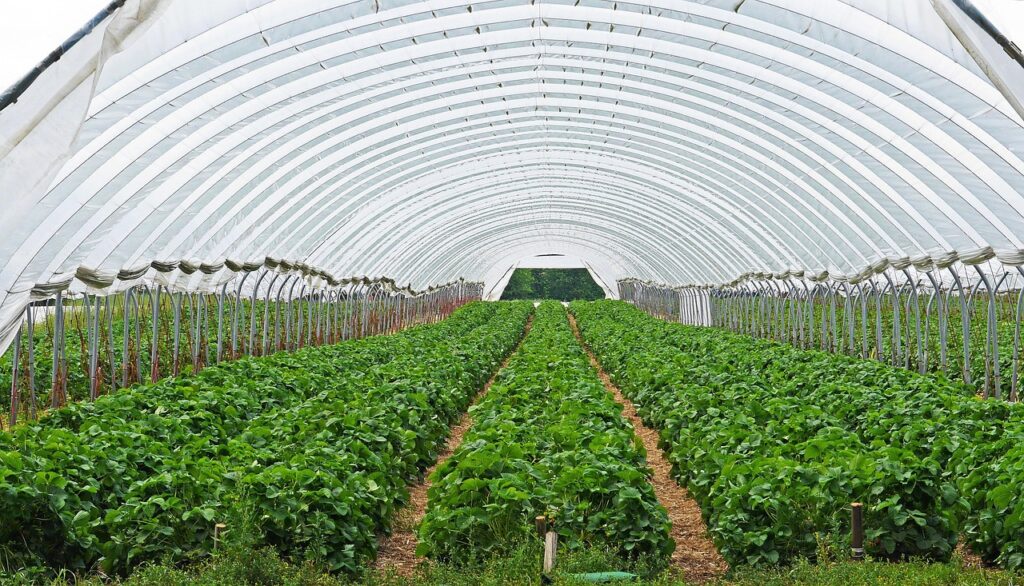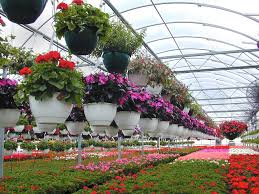Agriculture is witnessing a revolution with the advent of cutting-edge farming practices, and polyhouse farming leads the pack in this revolution. Polyhouse farming is a type of controlled environment agriculture (CEA) that enables farmers to grow crops under a covered environment, offering various benefits compared to conventional farming techniques.
Learning about Polyhouses for Agriculture
My cousin once took me on a trip to a nursery to purchase tomato plants. While I was at the nursery, I saw something new to me—a polyhouse. I questioned my cousin about it, but he did not answer me adequately. Therefore, I made up my mind to inquire from the nursery owner about it.
The owner told me that a polyhouse is a plastic material-made greenhouse, which controls temperature, humidity, and light to make the environment ideal for plants. But, when I inquired about the cost of establishing one, I was surprised—it cost a lot.
That is when the owner informed me of a government subsidy that assists in lessening the expenditure associated with establishing a polyhouse. This economic assistance made the investment significantly cheaper for farmers.
What is Polyhouse Farming?
Polyhouse farming is protected cultivation in which crops are cultivated under a organized enclosure topped by polyethylene sheets. This encased environment aids in controlling temperature, humidity, and light, providing optimum growing conditions for the crops. Polyhouse farming, unlike open-field farming, facilitates cultivation throughout the year with increased productivity.

Types of Polyhouse
Polyhouses are categorized according to their structure and level of technology. The two prominent types are:
Naturally Ventilated Polyhouse: This variation depends on natural ventilation for climatic and humic control. It is cheaper and ideal for moderate climates.
Climate-Controlled Polyhouse: With automation of climate-controlling systems, this variety suits extreme weather climates.
Low-Cost Polyhouse: Using cheap materials, low-cost polyhouses are perfect for smallholder farmers seeking to use a less expensive option.
Shade Net Polyhouse: Modified version using shade nets to moderate sunlight intensity and is frequently used for light-sensitive crops.
Polyhouse vs Greenhouse
Lots of individuals conflate polyhouses with greenhouses. Although the two are alike in that both are controlled environment agriculture systems, they are greatly different.
1. Structure and Material
Polyhouse: Assembled from polyethylene sheets kept in place with a metal or PVC frame.
Greenhouse: Assembled out of glass or polycarbonate panels with an even stronger framework, providing durability.
2. Cost and Investment
Polyhouse: Less costly, lower installation costs, viable for small-scale and medium-scale farmers.
Greenhouse: More expensive but lasts longer, suitable for commercial-scale farming on large scale.
3. Climate Control and Durability
Polyhouse: Basic to moderate climate control; can last between 5-10 years based on maintenance.
Greenhouse: Higher-class climate control with high automation level; highly durable, more than 15 years.
4. Usage and Scalability
Polyhouse: Suitable for vegetable and flower cultivation, especially for small and medium-sized farms.
Greenhouse: Employed for mass production of vegetables, exotic fruits, and high-value crops that need exact conditions.
5. Energy Consumption
Polyhouse: Lowers energy consumption with uncomplicated ventilation systems.
Greenhouse: Uses more energy input in heating, cooling, and controlled climate.
Advantages of Polyhouse Farming
Climate Control: Allow farmers to control temperature, humidity, and light, enabling the growth of crops year-round.
Increased Yield: The environment-controlled situation brings improved productivity over open-field cultivation.
Pest and Disease Protection: The shielded space minimizes opportunities for pest attack and plant diseases.
Water Conservation: Drip irrigation is used in polyhouse farming, minimizing water loss.
Land Efficient Use: Small farmers can also obtain high productivity through intensive cultivation techniques.
Protection from Severe Weather: The plants are protected from severe weather like heavy rain, frost, or scorching heat.
Better Crop Quality: Fruits and vegetables cultivated in polyhouses tend to be of better texture, color, and nutritional value.
Polyhouse Farming Cost
The price of establishing a polyhouse also varies based on factors like size, type, material used, and integration of technology. This is a general estimate of cost:
Low-Cost Polyhouse: ₹400–₹600 per square meter
Medium-Scale Polyhouse: ₹800–₹1,200 per square meter
Hi-Tech Polyhouse (Climate-Controlled): ₹1,500–₹3,000 per square meter, depending on the degree of automation, climate control options, and material quality. Highly advanced polyhouses with built-in IoT-based monitoring systems and automated irrigation can cost on the higher side of this price range.
Other expenses are irrigation systems, automation, fertilizers, and maintenance. But the increased initial investment is worth it in terms of greater yield and improved crop quality.
Subsidy for Polyhouse Farming
To encourage sustainable cultivation, central and state governments of India provide polyhouse farming subsidies. Some major schemes are:
National Horticulture Mission (NHM): Offers a maximum of 50% subsidy for building polyhouses.
State Government Schemes: Different state governments provide from 50% to 75% subsidy based on area and farmer category.
NABARD Assistance: Polyhouse can be established through loans and financial support for farmers by NABARD.
These subsidies can be accessed by farmers in local agriculture department offices or web portals of government schemes. With regard to protected farming, there is a difference between greenhouse and polyhouse.
Both have controlled environments, yet greenhouses consist of glass or polycarbonate panels and are employed in larger-scale cultivation, while polyhouses employ polyethylene sheets and are economical for smaller to medium-sized cultivation. Greenhouses are more insulated and durable, but polyhouses offer a cheaper and more flexible option for farmers who want to maximize production with minimal resources.
Technology in Polyhouse Farming

The use of automation and IoT-based monitoring systems in polyhouse farming improves efficiency. Technologies like:
Automated Irrigation Systems
Temperature and Humidity Sensors
Artificial Lighting for Extended Crop Growth Cycles assist in maximizing crop yields. Fogging and misting systems are also being installed in modern polyhouses to control humidity and temperature more precisely.
Polyhouse Farming Crop List
- Vegetables
Tomatoes: In demand in polyhouses for high production and quality.
Cucumbers: Well-suited to environments in a polyhouse, where high-quality fruits are produced.
Peppers (Capsicum): Can be easily cultivated in a polyhouse, particularly for varieties based on color.
Spinach: Develops rapidly in a polyhouse with sustained temperature and light.
Lettuce: A leafy vegetable with rapid growth suited to polyhouse conditions.
Carrots: Polyhouses provide the even growth and pest protection needed by carrots.
Radishes: Ideal for polyhouse cultivation due to their short growth phase.
- Fruits
Strawberries: Do well in polyhouses, yielding bigger and sweeter fruit.
Melons: Such as watermelon and muskmelon, do very well in a controlled environment.
Grapes: Are grown year-round in a polyhouse with suitable temperature control.
Papaya: A tropical fruit that is aided by the consistent conditions of a polyhouse.
- Herbs
Basil: Does well in polyhouses, yielding fresh herbs in high quantities.
Mint: Does very well in controlled environments, without pests and diseases.
Coriander: May be cultivated throughout the year with suitable conditions in a polyhouse.
Chives: Grow fast and profusely in a controlled greenhouse condition.
- Flowers
Geraniums: Yield exquisite flowers throughout the year in a polyhouse.

Orchids: Grow well in the controlled conditions of a polyhouse, yielding quality blooms.
Chrysanthemums: Cultivate well in a polyhouse, particularly in colder climates.
- Medicinal Plants
Aloe Vera: Cultivates well in polyhouses, yielding high-quality gel for medicinal purposes.
Ginseng: A valuable crop that is enhanced by the consistent temperature in a polyhouse.
Stevia: A sweetener crop that can flourish in polyhouse conditions.
Polyhouses create a controlled condition in which to grow many different types of crops, allowing farmers to maximize production, enhance quality, and lengthen the growing season.
Conclusion
Polyhouse farming is a revolution in contemporary agriculture, providing sustainable, high-productivity, and resource-conserving agricultural solutions. With heightened awareness and policy encouragement, farmers are increasingly embracing this technology to improve productivity and profitability.
For both commercial and small-scale farming, polyhouse farming is a promising way to address the rising demand for quality produce.
By embracing polyhouse farming, we move closer to a cleaner, more efficient, and sustainable agriculture future. Polyhouse farming is not only an innovation but a requirement in this era of climate change and limited resources. If you are contemplating polyhouse farming, investing in proper infrastructure and taking advantage of available subsidies will enable you to reap maximum returns while maintaining a consistent supply of fresh, high-quality produce all year round.
Know about the author. this article published when i was doing digital marketing course in Mysore

Hi, this is a comment.
To get started with moderating, editing, and deleting comments, please visit the Comments screen in the dashboard.
Commenter avatars come from Gravatar.